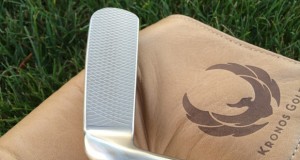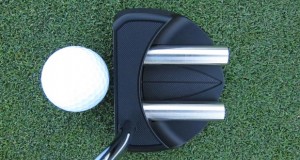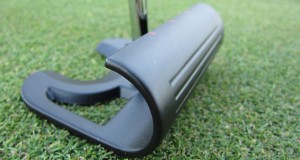 Q-Roll Golf is a small putter company with a big idea that literally turns conventional wisdom upside down. The idea is called Radius Face Technology, and it challenges the widely accepted notion that a putter needs a lofted face to lift the ball out of its natural depression on the green. Is Q-Roll Golf out on a limb—or is it ahead of the pack?
Q-Roll Golf is a small putter company with a big idea that literally turns conventional wisdom upside down. The idea is called Radius Face Technology, and it challenges the widely accepted notion that a putter needs a lofted face to lift the ball out of its natural depression on the green. Is Q-Roll Golf out on a limb—or is it ahead of the pack?
Following is PutterZone.com’s review of Q-Roll’s Classic IV face-balanced mallet putter ($149 at Edwin Watts), one of four models belonging to the Q-Roll Classics Collection.
The Storyline
With Q-Roll’s patented radius face putters, the leading edge of the putter face strikes the ball above its equator in the pursuit of immediate topspin for a truer roll. The radius face (see second photo) is essentially an inversion of the lofted face found on most putters, in which the leading edge of the face strikes the ball below its equator in order to safely lift the ball from its presumed natural indentation in the grass. Both designs (depending on the amount, or lack, of loft) aspire to minimize the skidding and hopping phenomena that can wreak havoc on distance control and overall accuracy.
 To demonstrate the science of the radius face, Q-Roll employs the analogy of a pool table. If you strike a cue ball below its equator, it will jump and skid. If you strike a cue ball at its equator, you might still get some skid. According to Q-Roll, these actions are similar to those produced by lofted-face and flat-face putters. But if you strike a cue ball just above its equator, you get a smooth, true roll. Hence, the logic of Q-Roll’s radius face design (which is billed as an improvement over the radius-type face featured earlier in Tear Drop brand putters).
To demonstrate the science of the radius face, Q-Roll employs the analogy of a pool table. If you strike a cue ball below its equator, it will jump and skid. If you strike a cue ball at its equator, you might still get some skid. According to Q-Roll, these actions are similar to those produced by lofted-face and flat-face putters. But if you strike a cue ball just above its equator, you get a smooth, true roll. Hence, the logic of Q-Roll’s radius face design (which is billed as an improvement over the radius-type face featured earlier in Tear Drop brand putters).
Simple, right? Not so fast. Nearly every putter in your local golf shop, as well as on the PGA Tour, features some form of loft—operating from the perspective that a putting green is naturally much softer than a pool table or other hard surface. Golf Digest recently spoke for conventional wisdom by stating: “A putter
In his book The Art of Putting, leading short game instructor Stan Utley even declared, “I firmly believe most players don’t have enough loft on their putters.”
In a recent interview with PutterZone.com, however, Q-Roll Golf’s founder Larry Garcia stated: “In the period since the introduction of lofted face putters, there have been significant improvements in the grass used on putting greens, and in their conditioning. Today, you can hardly detect the golf ball indentation on the green that so many manufacturers claim is the reason why the loft is needed, and that is to get the ball out of the indentation. It should be apparent that flat and lofted face technology is a thing whose time has come and gone.”
According to Q-Roll Golf, independent testing by Swing Dynamics found Q-Roll putters to “have more true roll energy than any other putter we (Swing Dynamics) have tested to date.” On that note, Garcia issued an open challenge to the putter industry “to come forward, subject themselves to robotic testing on a straight-up basis with no gimmicks or biases, and if any manufacturer either matched or beat our robotic results, we would so acknowledge them publicly.” He said he’s had no takers.
The View from PutterZone.com
Let’s skip the potatoes and get right to the meat: the Q-Roll Classic IV delivers on its promise of remarkable roll.
I took it out to the practice green along with eight other leading putters. Each of these putters retails for more than $150, so it was a fair, if unscientific, fight. I should add that I reside in a dry, sunny climate, and that testing took place in the evening, when the greens were hard and quick, which I presume are optimal conditions for a putter that spurns the notion of static ball indentation. I was unable to test amid spongier conditions.
In matters of optimal roll, the Q-Roll putter was the most consistent of the group on a mixture of long, medium and short putts. I saw some of my own 30-foot putts glide smoothly like, well, a cue ball over a field of felt.
Does this mean that the Q-Roll Classic IV was my favorite putter of all the putters in the test group? Not necessarily. Successful putting is more than just a function of roll potential—it’s also a function of aim, alignment, feedback, feel, confidence and overall personal chemistry with your putter. When I discover the perfect putter that works for everyone, I’ll let you know.
The bottom line, however, is that Q-Roll’s remarkable roll is a huge selling point and a nifty calling card—especially when it’s achieved with a concept that challenges the conventional wisdom of putter design.
I don’t want to start any fights about loft. I’m neither a physicist nor a professional. I’m just reporting what I experienced. There are plenty of golfers out there, including your favorite PGA Tour stars, who are stroking the ball just fine with lofted putters. A lot of it surely has to do with stroke mechanics, playing conditions and overall ability.
The lofted putter may still be the right choice for many—but that doesn’t mean Q-Roll is wrong. Based on my experience with the Q-Roll Classic IV, the debate about loft could get very interesting as Q-Roll gains market momentum.
True to its name, the Q-Roll Classic IV boasts a classic mallet design, with an elegant gold finish and a simple white sightline and corresponding white dot on the crown. It is milled from high-quality brass nickel alloy. The entire Q-Roll Classics Collection definitely appeals to those who prefer a traditional look in their putter. Personally, I’m not convinced that traditionalists are the ideal target audience for such a progressive concept as the radius face. Q-Roll Golf seems to have a technological tiger by the tail with its radius face concept, and it will be very interesting to see where they take it from here.
The Bottom Line
The Q-Roll Classic IV is classy putting instrument for those who seek progressive technology within a traditional design. At $149, it could also be considered a best buy. Q-Roll’s radius face works as advertised, and not just in slow-motion video or robotic testing, but right before your eyes. If your putting is plagued by skidding on the green, then you will definitely want to consider Q-Roll’s Classics Collection as a way to raise your game.
 PutterZone – Best Putter Reviews
PutterZone – Best Putter Reviews




Having just purchased a Q-Roll II Putter, I can verify that it gives the ball a great roll. There is so much conflicting information out there about rolling the golf ball. On the one hand, Stan Utley says that most people don’t have enough loft on their putters, then he turns around and says that you need to keep your hands ahead of the ball in a slight forward press and strike the ball on the downswing effectively pinching it against the grass to get it rolling.
It all seems counter intuitive to me. Why not have a putter with 1) a bit of negative loft and 2)strike the ball above the equator 3) on a bit of an upswing to immediately produce topspin.
Now, this is the first thing about rolling the golf ball that has made sense to me in a long time.
I am taking this putter out to the golf course today for the first time.
The Q-Roll putter has me pretty excited as I’m taking it out for its first round of golf today.
By the way, it is a beautifully manufactured product.
Wish me luck !!
steve